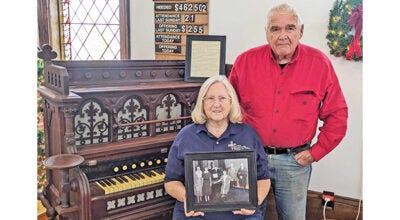Fruit Belt fading fast
Published 10:56 am Thursday, June 12, 2014
BERRIEN COUNTY — Abraham Lincoln once said, “The greatest fine art of the future will be the making of a comfortable living from a small piece of land.”
Living in Berrien County, particularly in the summer, one might think that the future Lincoln spoke of is now. Alongside any country road, one can find a farm stand offering some variety of fruit or vegetable, and every town seems to have a farmers market that sets up at least once a week. It makes one think that we truly do live in the “Great Fruit Belt.”
“It’s pretty well known that we’re second in crop diversity only to California,” said Lee LaVanway, president, CEO and market master of the Benton Harbor Fruit Exchange. “As a temperate zone, we’re probably number one.”
As such, residents and tourists should be able to find a cornucopia of Michigan produce in every supermarket in the region, but taking a trip to any of the local groceries will show you that, in 2014, such is not the case. Rather, finding produce advertised as “Michigan grown” is pretty rare—even during the peaks of the various harvest seasons.
“The volumes that we’re producing of this vast diversity now are so minuscule that they don’t make a great impact,” LaVanway said. “For example, in 1954, over 150,000 16-quart crates of strawberries were delivered in a single day to the Benton Harbor Fruit Market, which is a phenomenal amount. Today, the amount for the entire season won’t be 1,000, so we’ve lost more than 99 percent of our strawberry industry. We just don’t grow them anymore.”
In fact, Berrien County—once “the genesis of the Great Fruit Belt” as LaVanway called it—is nowhere near the self-sufficiency that Lincoln described, and we rely heavily on the outside world to feed us.
“We have a $500 million gap between what we consume and what we produce in this county,” explained Mark Moreno, associate professor of architecture at Andrews University and founding director of the New Berrien Food Foundation. “We’re spending $680 million, and we’re producing less than $100 million.”
Chicken production and consumption in Berrien County provide a perfect example of the problem.
“We eat 2.7 million chickens in Berrien County,” LaVanway said, citing data collected by the U.S. Department of Agriculture, the U.S. Department of Commerce, and the U.S. Census Bureau. “The problem is that we only grew about 1,500 of them. So, they’re not our chickens. It’s a huge shortfall between what we’re consuming and what we’re producing, and that’s true across the board—for every single food item.”
Beyond the production-consumption gap, Berrien County is also blighted by the existence of “food deserts” in Galien, Watervliet and Benton Harbor, and Eau Claire will soon join that list when their local Harding’s grocery store closes its doors.
According to the USDA, “food deserts” are “urban neighborhoods and rural towns without ready access to fresh, healthy, and affordable food. Instead of supermarkets and grocery stores, these communities may have no food access or are served only by fast food restaurants and convenience stores that offer few healthy, affordable food options.”
“It’s kind of sinful that, in the Fruit Belt, we will have four food deserts,” Moreno said.
Thus, instead of the robust agricultural legacy that Berrien County once had, we are now faced with food insecurity—relying on food that travels an average of 1,500 miles from farm to table. That could take up to a month in some cases.
That may not seem like a big deal as long as the food is not rotten when it gets to your dinner table. However, as LaVanway noted, produce begins losing its nutritional value as soon as it is harvested, and then there is the amount of fuel required by routinely transporting food such long distances.
That is why Moreno, coming from a background in New Urbanism, and LaVanway have joined forces with other concerned stakeholders, including local farmers and consumers, to form the New Berrien Food Foundation.
Their vision is that “Berrien County will be known for making local food a high community priority, restoring the strongest possible relationship between local farmers, fellow citizens and the agricultural land on which we live.”
To achieve that vision, Moreno, LaVanway and other supporters of the movement have prioritized three core goals.
“We want to make sure that we have local food in local schools, we want to have programs within the schools to educate kids and get them more involved in local foods, and we want to eliminate local food deserts in the county,” Moreno explained.
Together, they are working on plans to create and fund a processing facility large enough to provide a sense of security for farmers in the region. That facility would work on a principle of transparency, allowing consumers not only to see how the food is processed, but to know where it was grown and by whom, and the date it was harvested. Local markets would then sell the foods throughout the county. Those facilities could become integral parts of the growing agri-tourism trend in the region.
“The legacy of the Great Fruit Belt was that it could feed millions of people beyond its borders, and that’s all been reversed,” Moreno said. “So, we’re trying to create a new legacy for the Great Fruit Belt— that it can feed its own local people again and continue to feed others as well.”
If you are interested in learning more about the New Berrien Food Foundation or in joining them as they pursue their vision for self-sustenance in Berrien County , Moreno can be reached at mmoreno@andrews.edu, and LaVanway can be reached at llavanway@gmail.com.






